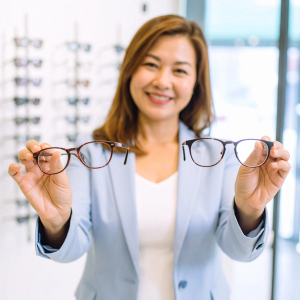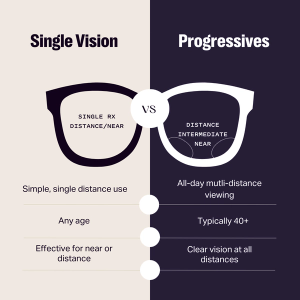Single Vision or Progressive Lenses: What’s Right for You?
Author: Alexander Martin, OD FAAO
Understanding the benefits of both—and why progressives might be worth considering
LEARN MORE
Single Vision or Progressive Lenses: What’s Right for You?
Understanding the benefits of both—and why progressives might be worth considering
If you’ve ever held your phone at arm’s length to read a text or squinted at a distant sign, you’re not alone. Our vision changes over time—and so do the lenses that support it. When it comes to eyeglasses, choosing between single vision and progressive lenses can impact how you see the world each day.
Let’s break down the differences—so you can choose what’s right for you.
Single vision vs. Progressives
Which is best for you?

Single Vision
- One prescription zone
- Simple, single-distance use
- Suitable for any age
- No visual transition
- No visible lines
- Minimal adjustment period needed
- Task-specific

Progressives
- Three prescription zones (distance, intermediate, near)
- All-day, multi-distance viewing
- Typically meant for 40+
- Seamless, gradual visual transition
- No visible lines
- Could take a few days to adjust to
- All-in-one solution
What Are Single Vision Lenses?
Single vision lenses have one consistent prescription throughout the lens. They're designed to correct either:
- Distance vision (e.g. for driving or watching a movie)
- Near vision (e.g. for reading, texting, or needlework, if that’s your cup of tea)
They’re a great choice if you only need help with one field of vision. Many younger adults or people with straightforward prescriptions use single vision lenses.
What Are Progressive Lenses?
Progressive lenses offer a smooth, gradual shift in power from the top of the lens to the bottom. That means you can:
- See far away (top zone)
- Focus on things like your computer or dashboard (middle zone)
- Read your phone or a book (bottom zone)
Unlike bifocals or trifocals, progressives don’t have any visible lines—and there’s no sudden “jump” between prescription powers.
Why Progressives Might Be Worth It
If you’re starting to notice blurry vision up close or far away—and especially if you’re tired of switching glasses—progressives could be your answer. They’re designed to match your day-to-day life, so you can move between reading, working, and walking without interruption.
They may cost more up front, but they offer:
- Greater freedom and convenience
- A more natural way to see
- A long-term solution as your vision evolves
Not Sure Which Is Right for You?
Try the Eyebot vision test—it’s free, takes just 90 seconds, and gives you an up-to-date, doctor-reviewed prescription. From there, you’ll know exactly what lenses are right for you—whether you’re sticking with single vision or making the switch to progressives.
single vision or progressives
What's best for you?
If you struggle seeing from distance and near, you may want to consider progressive lenses. Progressives will allow you to move throughout your day with the same pair of glasses, seamlessly adjusting to the correction that you need.

